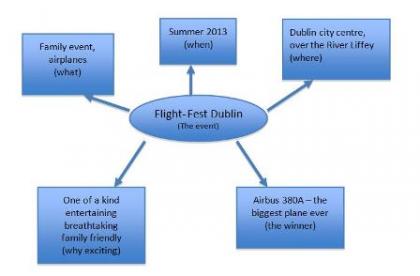IELTS Preparation Unit 3: Speaking
Hi there, I’m Norbert and I teach English in Kaplan Dublin. I’ve been teaching for over 8 years and have taught IELTS for a while now.
I’ll be giving you tips to help you prepare for your exams. I’m also looking forward to hearing from you.
In speaking part 2, candidates are required to talk about a particular topic for at least 2 minutes.
Make sure you’re prepared to talk a bit longer and let the examiner stop you; this will make a good impression on the examiner.
Candidates are given a statement and some supporting questions and have 1 minute to prepare for the task.
Today, we’re going to look at maximizing your efficiency and ways of making the most out of the time you’re given. We look at creating mind maps and taking quick notes to help you do well in the exam.
Some general tips to start off the exercise:
- read the instructions
- look at and highlight/underline keywords
- quickly analyze the grammar point of the question
- make quick notes using a mind map
Now let’s take a look at the following example.
Describe an exciting competition or sporting event you have witnessed.
You should say:
what the competition or sporting event was
when and where it took place
who won
and explain why it was exciting.
(Speaking for IELTS, Karen Kovacs, HarperCollins Publisher, 2011, ISBN: 978-0-00-742325-5)
As you can see in the example, there are three verbs that give you instructions: describe, say, explain.
You can highlight some of the key words used in the task to help you structure your answers: exciting, competition, sporting event, witness. Make sure to use synonyms where possible to increase your range of vocabulary used in your answers.
Quickly analyze the grammar; in this case the tenses used. We have two tenses here, the present perfect simple and the past simple. Make sure you use both of these tenses in your answers, and if you’re going to talk about a regular event (annual), make sure you use the present simple as well.
Now, let’s take a look at creating a mind map for this particular example. Mind maps are used for generating (brainstorming), expanding, and ordering your ideas. They’re easy to use and you can use them for both speaking and writing in IELTS.
In the above example I chose to talk about Flight Fest, a family-friendly event held in Dublin last year. You can follow my ideas counter-clockwise. Each box answers one of the questions in the task.
There are many other ways of noting down your ideas such as using tables.
| what Flight fest family event airplanes |
when summer 2013 |
where Dublin city centre, over the River Liffey |
why one of a kind entertaining breathtaking family friendly |
the winner Airbus 380A the biggest plane ever |
grammar past present perfect present |
Try and see which method you prefer, and let me know how you get on with your preparations.
Our other IELTS preparation articles:
1. Reading for Keywords
2. Capitalization
4. Writing on the Subject
5. Pronouncing "S" and "Z"
6. Reading to Expand Your Vocabulary
7. Listening Practice
8. Grammar: Nouns and Verbs


